A quantitative description of short-term plasticity at excitatory synapses in layer 2/3 of rat primary visual cortex
- PMID: 9315911
- PMCID: PMC6793910
- DOI: 10.1523/JNEUROSCI.17-20-07926.1997
A quantitative description of short-term plasticity at excitatory synapses in layer 2/3 of rat primary visual cortex
Abstract
Cortical synapses exhibit several forms of short-term plasticity, but the contribution of this plasticity to visual response dynamics is unknown. In part, this is because the simple patterns of stimulation used to probe plasticity in vitro do not correspond to patterns of activity that occur in vivo. We have developed a method of quantitatively characterizing short-term plasticity at cortical synapses that permits prediction of responses to arbitrary patterns of stimulation. Synaptic responses were recorded intracellularly as EPSCs and extracellularly as local field potentials in layer 2/3 of rat primary visual cortical slices during stimulation of layer 4 with trains of electrical stimuli containing random mixtures of frequencies. Responses exhibited complex dynamics that were well described by a simple three-component model consisting of facilitation and two forms of depression, a stronger form that decayed exponentially with a time constant of several hundred milliseconds and a weaker, but more persistent, form that decayed with a time constant of several seconds. Parameters obtained from fits to one train were used to predict accurately responses to other random and constant frequency trains. Control experiments revealed that depression was not caused by a decrease in the effectiveness of extracellular stimulation or by a buildup of inhibition. Pharmacological manipulations of transmitter release and postsynaptic sensitivity suggested that both forms of depression are mediated presynaptically. These results indicate that firing evoked by visual stimuli is likely to cause significant depression at cortical synapses. Hence synaptic depression may be an important determinant of the temporal features of visual cortical responses.
Figures
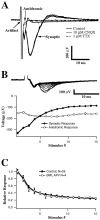
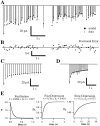
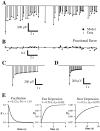


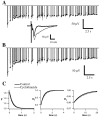

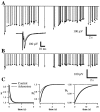
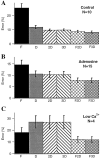


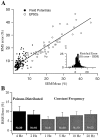
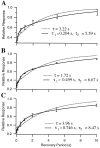

Similar articles
-
Multiple forms of short-term plasticity at excitatory synapses in rat medial prefrontal cortex.J Neurophysiol. 2000 May;83(5):3031-41. doi: 10.1152/jn.2000.83.5.3031. J Neurophysiol. 2000. PMID: 10805698
-
Adaptation at synaptic connections to layer 2/3 pyramidal cells in rat visual cortex.J Neurophysiol. 2005 Jul;94(1):363-76. doi: 10.1152/jn.01287.2004. Epub 2005 Mar 9. J Neurophysiol. 2005. PMID: 15758049
-
Two forms of synaptic plasticity with distinct dependence on age, experience, and NMDA receptor subtype in rat visual cortex.J Neurosci. 2003 Jul 23;23(16):6557-66. doi: 10.1523/JNEUROSCI.23-16-06557.2003. J Neurosci. 2003. PMID: 12878697 Free PMC article.
-
Role of Ca(2+) channels in short-term synaptic plasticity.Curr Opin Neurobiol. 2007 Jun;17(3):352-9. doi: 10.1016/j.conb.2007.04.005. Epub 2007 Apr 26. Curr Opin Neurobiol. 2007. PMID: 17466513 Review.
-
Advances in understanding visual cortex plasticity.Curr Opin Neurobiol. 2009 Jun;19(3):298-304. doi: 10.1016/j.conb.2009.05.010. Epub 2009 Jun 18. Curr Opin Neurobiol. 2009. PMID: 19540104 Free PMC article. Review.
Cited by
-
Synaptic depression and slow oscillatory activity in a biophysical network model of the cerebral cortex.Front Comput Neurosci. 2012 Aug 28;6:64. doi: 10.3389/fncom.2012.00064. eCollection 2012. Front Comput Neurosci. 2012. PMID: 22973221 Free PMC article.
-
Frequency-selective augmenting responses by short-term synaptic depression in cat neocortex.J Physiol. 2002 Jul 15;542(Pt 2):599-617. doi: 10.1113/jphysiol.2001.012759. J Physiol. 2002. PMID: 12122156 Free PMC article.
-
Spike timing in CA3 pyramidal cells during behavior: implications for synaptic transmission.J Neurophysiol. 2005 Aug;94(2):1528-40. doi: 10.1152/jn.00108.2005. Epub 2005 May 4. J Neurophysiol. 2005. PMID: 15872069 Free PMC article.
-
Relief of G-protein inhibition of calcium channels and short-term synaptic facilitation in cultured hippocampal neurons.J Neurosci. 2000 Feb 1;20(3):889-98. doi: 10.1523/JNEUROSCI.20-03-00889.2000. J Neurosci. 2000. PMID: 10648693 Free PMC article.
-
Neural field model of binocular rivalry waves.J Comput Neurosci. 2012 Apr;32(2):233-52. doi: 10.1007/s10827-011-0351-y. Epub 2011 Jul 12. J Comput Neurosci. 2012. PMID: 21748526
References
-
- Abbott LF, Sen K, Varela JA, Nelson SB. Synaptic depression and cortical gain control. Science. 1997;275:220–222. - PubMed
-
- Bode-Greuel KM, Singer W, Aldenhoff JB. A current source density analysis of field potentials evoked in slices of visual cortex. Exp Brain Res. 1987;69:213–219. - PubMed
-
- Bonds AB. Temporal dynamics of contrast gain in single cells of the cat striate cortex. Vis Neurosci. 1991;6:239–255. - PubMed
-
- Carandini M, Ferster D. Visual adaptation hyperpolarizes cells of the cat striate cortex. Science. 1997;276:949. - PubMed
Publication types
MeSH terms
Substances
Grants and funding
LinkOut - more resources
Full Text Sources
Molecular Biology Databases
